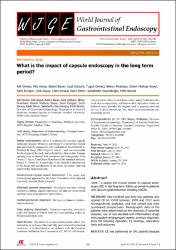| dc.contributor.author | Örmeci, Aslı | |
| dc.contributor.author | Akyüz, Filiz | |
| dc.contributor.author | Baran, Bülent | |
| dc.contributor.author | Göktürk, Suut | |
| dc.contributor.author | Örmeci, Tuğrul | |
| dc.contributor.author | Pınarbaşı, Binnur | |
| dc.contributor.author | Soyer Mutluay, Özlem | |
| dc.contributor.author | Evirgen, Sami | |
| dc.contributor.author | Akyüz, Ümit | |
| dc.contributor.author | Karaca, Çetin | |
| dc.contributor.author | Demir, Kadir | |
| dc.contributor.author | Kaymakoğlu, Sabahattin | |
| dc.contributor.author | Beşışık, Fatih | |
| dc.date.accessioned | 10.07.201910:49:13 | |
| dc.date.accessioned | 2019-07-10T20:04:39Z | |
| dc.date.available | 10.07.201910:49:13 | |
| dc.date.available | 2019-07-10T20:04:39Z | |
| dc.date.issued | 2016 | en_US |
| dc.identifier.citation | Örmeci, A., Akyüz, F., Akyüz, F., Göktürk, S., Örmeci, T., Pınarbaşı, B. ... Beşışık, F. (2016). What is the impact of capsule endoscopy in the long term period? World Journal Of Gastrointestinal Endoscopy, 8(7), 344-348. https://dx.doi.org/10.4253/wjge.v8.i7.344 | en_US |
| dc.identifier.issn | 1948-5190 | |
| dc.identifier.uri | https://dx.doi.org/10.4253/wjge.v8.i7.344 | |
| dc.identifier.uri | https://hdl.handle.net/20.500.12511/4087 | |
| dc.description | WOS: 000373288400004 | en_US |
| dc.description | PubMed ID: 27076873 | en_US |
| dc.description.abstract | AIM: To assess the clinical impact of capsule endoscopy (CE) in the long-term follow-up period in patients with obscure gastrointestinal bleeding (OGIB). METHODS: One hundred and forty-one patients who applied CE for OGIB between 2009 and 2012 were retrospectively analyzed, and this cohort was then questioned prospectively. Demographic data of the patients were determined via the presence of comorbid diseases, use of non-steroidal anti-inflammatory drugs anticoagulant-antiaggregant agents, previous diagnostic tests for bleeding episodes, CE findings, laboratory tests and outcomes. RESULTS: CE was performed on 141 patients because of OGIB. The capsule was retained in the upper gastrointestinal (GI) system in two of the patients, thus video monitoring was not achieved. There were 139 patients [62% male, median age: 72 years (range: 13-93 years) and a median follow-up duration: 32 mo (range: 6-82 mo)]. The overall diagnostic yield of CE was 84.9%. Rebleeding was determined in 40.3% (56/139) of the patients. The rebleeding rates of patients with positive and negative capsule results at the end of the follow-up were 46.6% (55/118) and 4.8% (1/21), respectively. In the multivariate analysis, usage of NSAIDs, anticoagulant-antiaggregant therapies (OR = 5.8; 95% CI: 1.86-18.27) and vascular ectasia (OR = 6.02; 95% CI: 2.568-14.146) in CE were detected as independent predictors of rebleeding. In the univariate analysis, advanced age, comorbidity, and overt bleeding were detected as predictors of rebleeding. CONCLUSION: CE is a reliable method in the diagnosis of obscure GI bleeding. Negative CE correlated with a significantly lower rebleeding risk in the long-term follow-up period. | en_US |
| dc.language.iso | eng | en_US |
| dc.publisher | Baishideng Publishing Group Inc | en_US |
| dc.rights | info:eu-repo/semantics/openAccess | en_US |
| dc.rights | Attribution-NonCommercial 4.0 International | * |
| dc.rights.uri | https://creativecommons.org/licenses/by-nc/4.0/ | * |
| dc.subject | Capsule Endoscopy | en_US |
| dc.subject | Small Bowel | en_US |
| dc.subject | Obscure Gastrointestinal Bleeding | en_US |
| dc.subject | Rebleeding | en_US |
| dc.title | What is the impact of capsule endoscopy in the long term period? | en_US |
| dc.type | article | en_US |
| dc.relation.ispartof | World Journal Of Gastrointestinal Endoscopy | en_US |
| dc.department | İstanbul Medipol Üniversitesi, Tıp Fakültesi, Dahili Tıp Bilimleri Bölümü, Radyoloji Ana Bilim Dalı | en_US |
| dc.authorid | 0000-0001-8532-4917 | en_US |
| dc.identifier.volume | 8 | en_US |
| dc.identifier.issue | 7 | en_US |
| dc.identifier.startpage | 344 | en_US |
| dc.identifier.endpage | 348 | en_US |
| dc.relation.publicationcategory | Makale - Uluslararası Hakemli Dergi - Kurum Öğretim Elemanı | en_US |
| dc.identifier.doi | 10.4253/wjge.v8.i7.344 | en_US |



















